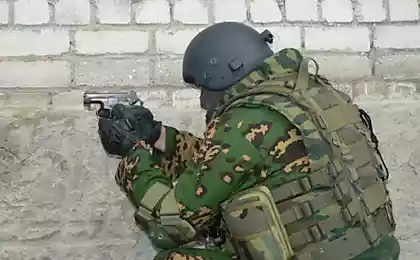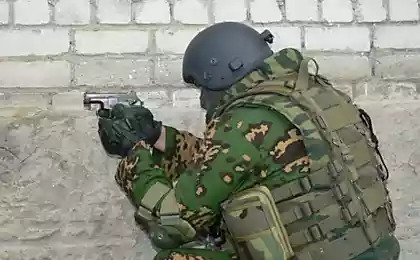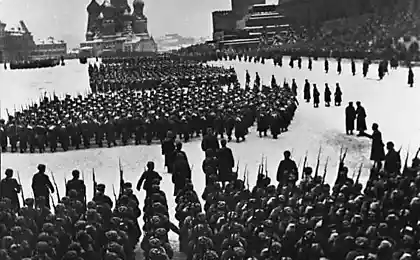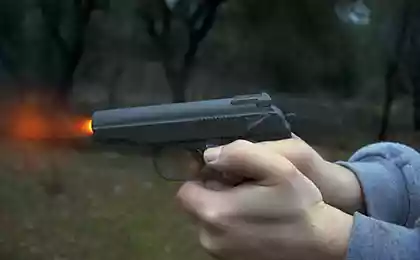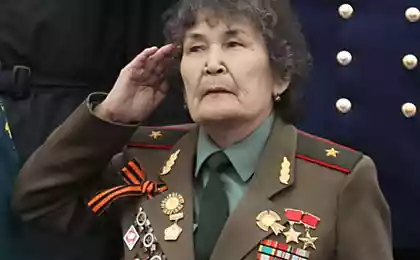1078
Weapon of Victory
LA 5
La-5 fighters appeared in circumstances not quite ordinary, not to say dramatic, for the design team headed by SA Lavochkin. Fighter LaGG-Z. for the production and improvement of who is responsible is the Design Bureau, in view of the lack of effectiveness of out products. The very existence of the KB is now proved questionable. Of course, the designers perfectly understand the nature of the shortcomings Lugg and have led design work on it a fundamental modification. Along with the need for dramatic improvement of flight data, especially in this case was the speed and continuity of design requirement LaGG-Z and his new version. Only under these conditions it was possible to convert the plant to manufacture new aircraft before the conveyor will be (as planned) Yak. And with this task CB SA Lavochkin successfully coped.

Through modification of the LaGG designers focused on promising new air-cooled engine M-82 AD Shvetsov. Thanks to its significantly higher capacity in comparison with the M-105P fighter LaGG-5 has acquired the qualities which he lacked as: significantly increased the speed and rate of climb, improved vertical maneuverability. The new aircraft was established in the spring of 1942, August 6, the Resolution T-bills, and 2 days later the order NCAP number 683, according to which the new fighter was named the La-5 - "Lavochkin-5", and after testing it under the brand name La-5, immediately launched into a series.
In addition to increased reliability, the most important way to improve the La-5 was weight reduction. Replacing electric starting motor in the air gave savings of 20 kg, improving the quality of gluing - another 20, removing the cargo in the tail -15 kg, then "cleaned up" piping and control wiring. As a result, take-off weight was reduced from 3370 kg in the prototype to 3200 kg in the series.
Introduce advanced process technology allows to increase the rate of release of the La-5. For example, the first hoods La-5 had to "beat" manually, July 1, 1942 have been handed over the first stamps, which provided details of the daily release of 2 airplanes by the end of the month organized a new site with a daily capacity of 6 sets. The same happened with casting and forging. Across the glider was working to replace the Delta timber to normal. In the end of the "Delta" did only strength frames, spars and the tail trim in particularly loaded areas. No loss of strength managed to reduce the weight of the aircraft and its cost.
Engine. Factory guaranteed operating time M-82A to repair 100 hours, but the actual resource was less. Due to the deterioration of the fitting of piston rings and steam in the combustion chamber of the lower cylinder flocked oil, engine smoked and zakapchival entire fuselage. But if not all together oil discharged through the exhaust pipes, there is a hard impact on the compression stroke and, consequently, breakage or destruction of the connecting rod of the cylinder head. Used in the M-82 SH-12 candles kept for 5 hours, and during intense battles on a La-5 was required for 14 candles in a day. The problem lay in the failure form cylinder heads: the candles were constantly in the oil, which zakapchivalis, and soot settled lead from leaded gasoline.
Initially the flight manual of the aircraft La-5 M-82A allowed to keep takeoff (1700 hp) from the ground for 5 minutes. The prototype on this mode accelerated to 600 km / h, and at face value (1400 hp) only to 515 km / h. But if the pilot was fond of or turn off the afterburner on time, the new engine within 10 minutes of the wedge, and actuated not stretched and allowed 5 minutes. Combatant pilots are constantly reported that a La-5 of their group had not returned from the flight due to engine failure in battle. Conducted in LII tests confirmed the objectivity of claims and use afterburner in combat banned. Without it, the speed at ground level dropped to 505-510 km / h, from 600 to 580 km / h reduced speed on the 2nd border altitude and time of climb of 5,000 meters has increased from 5, 2 min from prototype to 6, 0.
The first La-5, as well as LaGG-3 had no slats and different tendency to stall the wing. The GKO number 1895ss on June 7, 1942 obliged to introduce mechanization of the wing leading edge to LaGG-3, La-5 from July 1, but by the end of the first decade of July it was possible to make only 7 LaGG-3 and 8 of the La-5. Only in August all the aircraft began to produce with the slats.
In the summer of 1942 La-5 carried out work to improve the fit of the chassis covers and sashes. Provide simultaneous release of the right and left of the slats, they drove better and easier. Provided the release flaps, the flaps on a bend, reducing its range and runtime. According to the research TsAGI changed the design and installation of the pitot tube. We will modify the electrical system.
July 24 order was issued NCAP and the Air Force №559a / C / 032 for use on fighter armor. First, on the La-5 established bronespinku and tanks entered retreading. Then, in accordance with the decision of the GKO number 2359ss from October 1, 1942 introduced a bulletproof windshield. In addition, this document also defines the use of fighter planes "La" and "Yak" red crosshair reticle illumination, button elektropnevmospuska guns of the type Me-109 instead of tight mechanical gashetok.
Order of NCAP number 605s dated August 8, since 10 August each La-5 was required to establish radio RSI-4, and one in three - and a transmitter and radiopolukompas RPK-10. Although in time (2 days!) Could not meet all the business has moved, and Soviet fighter planes began to receive funds navigation and communication.
By the end of 1942, Gorky began to publish La-5 with substantially modified nose section: finally gone double-covered fuselage became easier, reduce labor intensity. By the time the rear frame of the sliding skylight on the recommendation of TsAGI put stekatel, smoothing step between the cabin and fairing. Changed and the kinematics of the rear support are now firming up its wheels and flaps do not extend beyond the rear of the bypass.
In December 1942 he started production of La-5 at the factory number 31 in Tbilisi, where continued production and LaGG-3. By the end of the year the plant has built 22 new fighter and 5 passed at the beginning of the next. However, the plan for 1943 that provided the company increase production, "Lugg" in 1, 5 times while improving their LTH. In addition, Yakovlev sought transition Tbilisi plant to produce a new fighter Yak-3. In this situation, the director of the 31st Pivovarov managed to insist on the removal order for the La-5, and the continuation of the release, "Lugg," which though are better, but still could not compete with the Bf 109G and FW 190A.
The first air regiments, had armed the fighter appeared at the front in the autumn of 1942 at Stalingrad.
La-5 quickly gained recognition. Pilots liked not only by its high performance and powerful weapons (guns ShVAK two), but also air-cooled engine, which had a greater vitality than the liquid-cooled engine, and is also a protection against enemy fire from the front hemisphere.
Release of the first production version of La-5 to M-82A engine stopped in the summer of 1943 LA 5F
November 15 issued a decree on the further improvement of ICT Flight Information La-5 and elimination of the marriage. In response, the plant number 21 in three cars performed various complexes improvements. Common to them were the installation of the motor M-82 increased from 950 to 1140 mm Hg. Art. supercharged near the ground and improved exterior finish. The speed at ground level of the La-5 №8-53 reached 519 km / h on the denomination, afterburner - 550 km / h (2,700 m - 569 km / h).
Plane Ser. № 8-71 additionally received a new tunnel and the oil cooler pipe monitoring station. The rate on the I boundary altitude of 3200 m increased to 576 km / h, but the land on the afterburner was at 3 km / h less than the car № 8-53.
Aircraft № 8-50 addition had internal and external hood with improved sealing, new outlets of cooling air and exhaust pipes. At an altitude of 600 meters on the afterburner speed was 565 km / h, without - 530 km / h, and the border at I 3250 m altitude - 590 km / h.
On December 1, 1942 production of La-5 introduced sealing hoods, improved the quality of the surfaces and joints, finished the slats, increasing their strength and making more gradual release.
By that time, there was a modified M-82F engine, which has been improved afterburner control system, oil system and installed a new clutch monitoring station. The power of this option at an altitude of 600 m increased by 300 hp Compared to M-82A first boundary altitude it was reduced from 1580 to 800 m, but the capacity at this height increased from 1540 to 1760 hp (for this "battle" M-82F power surpassed even the M-82FN). The second boundary altitude at the M-82A and F was the same - at 5410 m able to develop 1330 hp Weight M-82F has grown by only 20 kg. Use this engine to La-5 prescribed order NCAP number 744 of 4 October.
By naming a new version of the engine fighter received index La-5F (intrafactory cipher - "type 38F"). On this machine, in addition to the updated ICH, introduced a fuselage fairing reduced, and the wing, empennage, landing gear, weapons systems, and left unchanged. In preparation for the launch of mass production of this version of the aircraft counted the strength, new construction in statzale SibNIA checked and approved. Prototypes built not by performing the entire cycle of the factory, state and military trials, as well as fine-tuning the aircraft in a short time at the head of the series. Due to the ease of construction and the removal of pieces of equipment take-off weight "standard" La-5F compared with La-5 M-82A has been reduced to 160 kg. The speed at ground level increased by 50 km / h, and the second boundary altitude - 20 km / h. Time set 5000 meters was reduced to 30, and the steady turn at an altitude of 1000 m is faster for 2-3 seconds. Initially, while using the afterburner has been limited, but with the April 1, 1943 the restriction was removed by order of NCAP №183.
However, carried out in August 1943 in the Research Institute of the Air Force test pilot series La-5F № 37-18 showed a decrease in speed at ground level in the 10 km / h, on the border of tall at 5 km / h and an increase in the time of climb 5km 30-40 in comparison with the machines head series. Decrease altitude occurred due to incorrect adjustment of the motor control wiring that was fixable. Worse appeared above normal temperature of the cylinder head.
From aircraft manufacturers were required not only to create new versions of the La-5, but also improve the quality of serial production. The troops complained that the distance La-5F is less guaranteed due to the unstable operation of the carburettor AK-82BP PERMITTED pereobogaschenie blend mode to "speed range". Control tests on the range in the most favorable mode at an altitude of 500-1000 m, carried out on La-5 M-82A number 37210444 release in October 1942, gave 970 km, the aircraft number 37212124, which was built in July 1943 - 820, and La -5F №37212501F handed over in June - 580 km at the same gas station to 340 liters. After that, based on the order number NCAP 602s from October 29, 1943 have developed and implemented a series on La-5 improved carburetor.
The GKO number 2378ss of 7 October 1942, the order number 763ss NCAP October 10, determined the release of La-5 at the factory number 381, who was evacuated from Leningrad to the Urals, Nizhny Tagil. At the same time with the company even made an order for IL-2, this value is now attached to the new fighter. Under the La-5 plant area handed 445 th (glider) Alapaevsk plant and sent 4,000 additional workers and engineers. But because the company began re-evacuation to Moscow in time to learn it new products failed. And only in the end of 1943 there passed the first La-5F collected from Gorky units, and then went full circle. Letter number 698s on March 23, 1943 and Director of the Lavochkin factory number 21 Aghajanov asked permission to release the lightweight 3050 kg aircraft La-5F with metal spars specifically for the "pilot-hunters", referring to the experience of the Germans and the Japanese. It was assumed in this version take 7-10% of the aircraft. According to the Resolution 3101 of the number of T-bills 03.31.1943, the plant number 381 from May 1943 had to switch completely to release the La-5 with metal spars. But in time this is not possible, and plan to release La-5 in 1943, the company is satisfied only by 55%. Other manufacturers La-5 job that year exceeded: Plant number 21 - 9, 2%, and the number 99 - 10, 2%.
In the spring of 1943 it was marked by the first cases of the cliff paintings, which papered wooden part of La-5F, issued on 21 th and 99 th plants. Innocuous at first cracks in the paint ends in disaster, and the beginning of June, this phenomenon has become widespread. The reason is not immediately understood. It turned out that nitroshpatlevke AL-22, which is applied after painting a green field camouflage enamel AMT-4, a lead crown was replaced by iron oxide without the consent of VIAM. Such putty began shipping in December 1942 and while it was cold, she was kept, but as soon as the sun began to bake, began to crack, and destroy the fabric gets wet, especially on the wing and stabilizer. The troops of these aircraft were about a thousand that threatened the leaders of various industries repression. Then immediately formed mobile teams to 3 weeks eliminate the risk of defects. In the area of the Kursk salient, they finished just 3 days before the start of the grand battle. Replacement deficit leaden crown found it was not possible. I had to stop the release of several fillers and primers, includes this component, and for fighters introduced a new camouflage scheme on the basis of gray paint.
During 1942 - 1944 years. industry produced 10003 La-5 fighter aircraft in different versions.

La-5FN
In March 1942, on an experimental engine M-82NV made on the basis of M-82A, AC-82BP carburetor replaced the unit direct injection "HB". The maximum power of the engine was able to lift up to 1850 hp It reaches to the combat mode before the first boundary of the altitude (1650 m), at a pressure of 1200 mm Hg pressurization. Art. and 2400 revs. / min. In the summer flight tests of M-82NV held on IL-4 and SU-2. September 12, 1942 Order of the NCAP number 698s factory number 21 must install the M-5 series 82NV La-5, to conduct their tests in conjunction with the FRI and the Air Force Institute, and by 10 October to send combat units for military trials. But 82NV motor M (M-82FN) demanded substantial improvements, and development units "NV" on the factory number 296 was delayed. However, in 1943 the plant number 19 was able to pass the 1520 M-82FN, however, the plan was to 2483.
But the problems have not only a motor. Lavochkin explained missed deadlines for the La-5 M-82NV the fact that the production plant is difficult to conduct experimental work, 8 of its machines in Moscow, and asked him to allocate as an additional base plant number 241 next to the LII in bulls. But he refused, and all work on the La-5 M-82NV continued at the old place, and April 2, 1943 an order was issued NCAP number 187ss, according to which the plant number 21 had to immediately begin production of La-5 with a new power plant to end of the month to pass 20 cars in May - 100, and in June - 150 in excess of the previously established plan for La-5F.
Technical specifications for La-5 "type 39" M-82FNV (designation M-82FN approved in mid-1943) Lavochkin approved April 21, 1943 Finally Burst mode the engine were set as follows: take-off (short-term) capacity of 1850 hp power at an altitude of 600 m - 1530 hp na1 border altitude of 1650 m - 1630 hp at the II 4650 m altitude border - 1430 hp Compared with the La-5F new aircraft weight increased by 55 kg due to a heavy engine.
The new modification of the fighter, which in the second half of 1943 received the designation La-5FN, began to produce an increasing pace. For the production of the machine is connected aggregate-assembly plant number 99 in the capital of Buryatia, Ulan-Ude. It was the first aircraft that built this plant on a full cycle, not all went wrong at first, but the staff still coped with the task.
Initially, La-5 equipped with propellers-105B with wooden blades that could not be restored in the case of lumbago or landing on the fuselage. Repaired, metal blades VISH-105B appeared in 1942, but at first they lacked only part of the fighters. July 17, 1943 issued a decree number 375ss T-bills, which required not only dramatically increase the production of La-5, but also increase the number of serviceable vehicles in service. It is obliged to supply the metal screws at least 15 of the 17 handed over daily La-5, while in the end of 1942 did not exceed 12.
In the fall of 1943, LII completed testing of three new propellers made by the number 467 for the La-5FN. According to their results at the end of 1943, series production started VISH-105B-4. Thanks to the new high-speed profiles TsAGI and change the twist of the blades, the aircraft's speed increased to 11 km / h, and the run-off distance decreased by 30 and 75 m, respectively.
On the La-5 engine is often "cut" after the establishment of more than 3/4 of filling, and sometimes during the remainder of 100 liters or more. The defect appeared in the drainage system, which does not provide equality of pressure in the wing and in the central tanks. The combat units struggled with this by drilling additional holes in the drainage pipes, which are connected tanks. In a series of them just stopped to put, apply individual drain each tank. It's simple, but it is a decision only introduced in November 1943
Source:
La-5 fighters appeared in circumstances not quite ordinary, not to say dramatic, for the design team headed by SA Lavochkin. Fighter LaGG-Z. for the production and improvement of who is responsible is the Design Bureau, in view of the lack of effectiveness of out products. The very existence of the KB is now proved questionable. Of course, the designers perfectly understand the nature of the shortcomings Lugg and have led design work on it a fundamental modification. Along with the need for dramatic improvement of flight data, especially in this case was the speed and continuity of design requirement LaGG-Z and his new version. Only under these conditions it was possible to convert the plant to manufacture new aircraft before the conveyor will be (as planned) Yak. And with this task CB SA Lavochkin successfully coped.

Through modification of the LaGG designers focused on promising new air-cooled engine M-82 AD Shvetsov. Thanks to its significantly higher capacity in comparison with the M-105P fighter LaGG-5 has acquired the qualities which he lacked as: significantly increased the speed and rate of climb, improved vertical maneuverability. The new aircraft was established in the spring of 1942, August 6, the Resolution T-bills, and 2 days later the order NCAP number 683, according to which the new fighter was named the La-5 - "Lavochkin-5", and after testing it under the brand name La-5, immediately launched into a series.
In addition to increased reliability, the most important way to improve the La-5 was weight reduction. Replacing electric starting motor in the air gave savings of 20 kg, improving the quality of gluing - another 20, removing the cargo in the tail -15 kg, then "cleaned up" piping and control wiring. As a result, take-off weight was reduced from 3370 kg in the prototype to 3200 kg in the series.
Introduce advanced process technology allows to increase the rate of release of the La-5. For example, the first hoods La-5 had to "beat" manually, July 1, 1942 have been handed over the first stamps, which provided details of the daily release of 2 airplanes by the end of the month organized a new site with a daily capacity of 6 sets. The same happened with casting and forging. Across the glider was working to replace the Delta timber to normal. In the end of the "Delta" did only strength frames, spars and the tail trim in particularly loaded areas. No loss of strength managed to reduce the weight of the aircraft and its cost.
Engine. Factory guaranteed operating time M-82A to repair 100 hours, but the actual resource was less. Due to the deterioration of the fitting of piston rings and steam in the combustion chamber of the lower cylinder flocked oil, engine smoked and zakapchival entire fuselage. But if not all together oil discharged through the exhaust pipes, there is a hard impact on the compression stroke and, consequently, breakage or destruction of the connecting rod of the cylinder head. Used in the M-82 SH-12 candles kept for 5 hours, and during intense battles on a La-5 was required for 14 candles in a day. The problem lay in the failure form cylinder heads: the candles were constantly in the oil, which zakapchivalis, and soot settled lead from leaded gasoline.
Initially the flight manual of the aircraft La-5 M-82A allowed to keep takeoff (1700 hp) from the ground for 5 minutes. The prototype on this mode accelerated to 600 km / h, and at face value (1400 hp) only to 515 km / h. But if the pilot was fond of or turn off the afterburner on time, the new engine within 10 minutes of the wedge, and actuated not stretched and allowed 5 minutes. Combatant pilots are constantly reported that a La-5 of their group had not returned from the flight due to engine failure in battle. Conducted in LII tests confirmed the objectivity of claims and use afterburner in combat banned. Without it, the speed at ground level dropped to 505-510 km / h, from 600 to 580 km / h reduced speed on the 2nd border altitude and time of climb of 5,000 meters has increased from 5, 2 min from prototype to 6, 0.
The first La-5, as well as LaGG-3 had no slats and different tendency to stall the wing. The GKO number 1895ss on June 7, 1942 obliged to introduce mechanization of the wing leading edge to LaGG-3, La-5 from July 1, but by the end of the first decade of July it was possible to make only 7 LaGG-3 and 8 of the La-5. Only in August all the aircraft began to produce with the slats.
In the summer of 1942 La-5 carried out work to improve the fit of the chassis covers and sashes. Provide simultaneous release of the right and left of the slats, they drove better and easier. Provided the release flaps, the flaps on a bend, reducing its range and runtime. According to the research TsAGI changed the design and installation of the pitot tube. We will modify the electrical system.
July 24 order was issued NCAP and the Air Force №559a / C / 032 for use on fighter armor. First, on the La-5 established bronespinku and tanks entered retreading. Then, in accordance with the decision of the GKO number 2359ss from October 1, 1942 introduced a bulletproof windshield. In addition, this document also defines the use of fighter planes "La" and "Yak" red crosshair reticle illumination, button elektropnevmospuska guns of the type Me-109 instead of tight mechanical gashetok.
Order of NCAP number 605s dated August 8, since 10 August each La-5 was required to establish radio RSI-4, and one in three - and a transmitter and radiopolukompas RPK-10. Although in time (2 days!) Could not meet all the business has moved, and Soviet fighter planes began to receive funds navigation and communication.
By the end of 1942, Gorky began to publish La-5 with substantially modified nose section: finally gone double-covered fuselage became easier, reduce labor intensity. By the time the rear frame of the sliding skylight on the recommendation of TsAGI put stekatel, smoothing step between the cabin and fairing. Changed and the kinematics of the rear support are now firming up its wheels and flaps do not extend beyond the rear of the bypass.
In December 1942 he started production of La-5 at the factory number 31 in Tbilisi, where continued production and LaGG-3. By the end of the year the plant has built 22 new fighter and 5 passed at the beginning of the next. However, the plan for 1943 that provided the company increase production, "Lugg" in 1, 5 times while improving their LTH. In addition, Yakovlev sought transition Tbilisi plant to produce a new fighter Yak-3. In this situation, the director of the 31st Pivovarov managed to insist on the removal order for the La-5, and the continuation of the release, "Lugg," which though are better, but still could not compete with the Bf 109G and FW 190A.
The first air regiments, had armed the fighter appeared at the front in the autumn of 1942 at Stalingrad.
La-5 quickly gained recognition. Pilots liked not only by its high performance and powerful weapons (guns ShVAK two), but also air-cooled engine, which had a greater vitality than the liquid-cooled engine, and is also a protection against enemy fire from the front hemisphere.
Release of the first production version of La-5 to M-82A engine stopped in the summer of 1943 LA 5F
November 15 issued a decree on the further improvement of ICT Flight Information La-5 and elimination of the marriage. In response, the plant number 21 in three cars performed various complexes improvements. Common to them were the installation of the motor M-82 increased from 950 to 1140 mm Hg. Art. supercharged near the ground and improved exterior finish. The speed at ground level of the La-5 №8-53 reached 519 km / h on the denomination, afterburner - 550 km / h (2,700 m - 569 km / h).
Plane Ser. № 8-71 additionally received a new tunnel and the oil cooler pipe monitoring station. The rate on the I boundary altitude of 3200 m increased to 576 km / h, but the land on the afterburner was at 3 km / h less than the car № 8-53.
Aircraft № 8-50 addition had internal and external hood with improved sealing, new outlets of cooling air and exhaust pipes. At an altitude of 600 meters on the afterburner speed was 565 km / h, without - 530 km / h, and the border at I 3250 m altitude - 590 km / h.
On December 1, 1942 production of La-5 introduced sealing hoods, improved the quality of the surfaces and joints, finished the slats, increasing their strength and making more gradual release.
By that time, there was a modified M-82F engine, which has been improved afterburner control system, oil system and installed a new clutch monitoring station. The power of this option at an altitude of 600 m increased by 300 hp Compared to M-82A first boundary altitude it was reduced from 1580 to 800 m, but the capacity at this height increased from 1540 to 1760 hp (for this "battle" M-82F power surpassed even the M-82FN). The second boundary altitude at the M-82A and F was the same - at 5410 m able to develop 1330 hp Weight M-82F has grown by only 20 kg. Use this engine to La-5 prescribed order NCAP number 744 of 4 October.
By naming a new version of the engine fighter received index La-5F (intrafactory cipher - "type 38F"). On this machine, in addition to the updated ICH, introduced a fuselage fairing reduced, and the wing, empennage, landing gear, weapons systems, and left unchanged. In preparation for the launch of mass production of this version of the aircraft counted the strength, new construction in statzale SibNIA checked and approved. Prototypes built not by performing the entire cycle of the factory, state and military trials, as well as fine-tuning the aircraft in a short time at the head of the series. Due to the ease of construction and the removal of pieces of equipment take-off weight "standard" La-5F compared with La-5 M-82A has been reduced to 160 kg. The speed at ground level increased by 50 km / h, and the second boundary altitude - 20 km / h. Time set 5000 meters was reduced to 30, and the steady turn at an altitude of 1000 m is faster for 2-3 seconds. Initially, while using the afterburner has been limited, but with the April 1, 1943 the restriction was removed by order of NCAP №183.
However, carried out in August 1943 in the Research Institute of the Air Force test pilot series La-5F № 37-18 showed a decrease in speed at ground level in the 10 km / h, on the border of tall at 5 km / h and an increase in the time of climb 5km 30-40 in comparison with the machines head series. Decrease altitude occurred due to incorrect adjustment of the motor control wiring that was fixable. Worse appeared above normal temperature of the cylinder head.
From aircraft manufacturers were required not only to create new versions of the La-5, but also improve the quality of serial production. The troops complained that the distance La-5F is less guaranteed due to the unstable operation of the carburettor AK-82BP PERMITTED pereobogaschenie blend mode to "speed range". Control tests on the range in the most favorable mode at an altitude of 500-1000 m, carried out on La-5 M-82A number 37210444 release in October 1942, gave 970 km, the aircraft number 37212124, which was built in July 1943 - 820, and La -5F №37212501F handed over in June - 580 km at the same gas station to 340 liters. After that, based on the order number NCAP 602s from October 29, 1943 have developed and implemented a series on La-5 improved carburetor.
The GKO number 2378ss of 7 October 1942, the order number 763ss NCAP October 10, determined the release of La-5 at the factory number 381, who was evacuated from Leningrad to the Urals, Nizhny Tagil. At the same time with the company even made an order for IL-2, this value is now attached to the new fighter. Under the La-5 plant area handed 445 th (glider) Alapaevsk plant and sent 4,000 additional workers and engineers. But because the company began re-evacuation to Moscow in time to learn it new products failed. And only in the end of 1943 there passed the first La-5F collected from Gorky units, and then went full circle. Letter number 698s on March 23, 1943 and Director of the Lavochkin factory number 21 Aghajanov asked permission to release the lightweight 3050 kg aircraft La-5F with metal spars specifically for the "pilot-hunters", referring to the experience of the Germans and the Japanese. It was assumed in this version take 7-10% of the aircraft. According to the Resolution 3101 of the number of T-bills 03.31.1943, the plant number 381 from May 1943 had to switch completely to release the La-5 with metal spars. But in time this is not possible, and plan to release La-5 in 1943, the company is satisfied only by 55%. Other manufacturers La-5 job that year exceeded: Plant number 21 - 9, 2%, and the number 99 - 10, 2%.
In the spring of 1943 it was marked by the first cases of the cliff paintings, which papered wooden part of La-5F, issued on 21 th and 99 th plants. Innocuous at first cracks in the paint ends in disaster, and the beginning of June, this phenomenon has become widespread. The reason is not immediately understood. It turned out that nitroshpatlevke AL-22, which is applied after painting a green field camouflage enamel AMT-4, a lead crown was replaced by iron oxide without the consent of VIAM. Such putty began shipping in December 1942 and while it was cold, she was kept, but as soon as the sun began to bake, began to crack, and destroy the fabric gets wet, especially on the wing and stabilizer. The troops of these aircraft were about a thousand that threatened the leaders of various industries repression. Then immediately formed mobile teams to 3 weeks eliminate the risk of defects. In the area of the Kursk salient, they finished just 3 days before the start of the grand battle. Replacement deficit leaden crown found it was not possible. I had to stop the release of several fillers and primers, includes this component, and for fighters introduced a new camouflage scheme on the basis of gray paint.
During 1942 - 1944 years. industry produced 10003 La-5 fighter aircraft in different versions.

La-5FN
In March 1942, on an experimental engine M-82NV made on the basis of M-82A, AC-82BP carburetor replaced the unit direct injection "HB". The maximum power of the engine was able to lift up to 1850 hp It reaches to the combat mode before the first boundary of the altitude (1650 m), at a pressure of 1200 mm Hg pressurization. Art. and 2400 revs. / min. In the summer flight tests of M-82NV held on IL-4 and SU-2. September 12, 1942 Order of the NCAP number 698s factory number 21 must install the M-5 series 82NV La-5, to conduct their tests in conjunction with the FRI and the Air Force Institute, and by 10 October to send combat units for military trials. But 82NV motor M (M-82FN) demanded substantial improvements, and development units "NV" on the factory number 296 was delayed. However, in 1943 the plant number 19 was able to pass the 1520 M-82FN, however, the plan was to 2483.
But the problems have not only a motor. Lavochkin explained missed deadlines for the La-5 M-82NV the fact that the production plant is difficult to conduct experimental work, 8 of its machines in Moscow, and asked him to allocate as an additional base plant number 241 next to the LII in bulls. But he refused, and all work on the La-5 M-82NV continued at the old place, and April 2, 1943 an order was issued NCAP number 187ss, according to which the plant number 21 had to immediately begin production of La-5 with a new power plant to end of the month to pass 20 cars in May - 100, and in June - 150 in excess of the previously established plan for La-5F.
Technical specifications for La-5 "type 39" M-82FNV (designation M-82FN approved in mid-1943) Lavochkin approved April 21, 1943 Finally Burst mode the engine were set as follows: take-off (short-term) capacity of 1850 hp power at an altitude of 600 m - 1530 hp na1 border altitude of 1650 m - 1630 hp at the II 4650 m altitude border - 1430 hp Compared with the La-5F new aircraft weight increased by 55 kg due to a heavy engine.
The new modification of the fighter, which in the second half of 1943 received the designation La-5FN, began to produce an increasing pace. For the production of the machine is connected aggregate-assembly plant number 99 in the capital of Buryatia, Ulan-Ude. It was the first aircraft that built this plant on a full cycle, not all went wrong at first, but the staff still coped with the task.
Initially, La-5 equipped with propellers-105B with wooden blades that could not be restored in the case of lumbago or landing on the fuselage. Repaired, metal blades VISH-105B appeared in 1942, but at first they lacked only part of the fighters. July 17, 1943 issued a decree number 375ss T-bills, which required not only dramatically increase the production of La-5, but also increase the number of serviceable vehicles in service. It is obliged to supply the metal screws at least 15 of the 17 handed over daily La-5, while in the end of 1942 did not exceed 12.
In the fall of 1943, LII completed testing of three new propellers made by the number 467 for the La-5FN. According to their results at the end of 1943, series production started VISH-105B-4. Thanks to the new high-speed profiles TsAGI and change the twist of the blades, the aircraft's speed increased to 11 km / h, and the run-off distance decreased by 30 and 75 m, respectively.
On the La-5 engine is often "cut" after the establishment of more than 3/4 of filling, and sometimes during the remainder of 100 liters or more. The defect appeared in the drainage system, which does not provide equality of pressure in the wing and in the central tanks. The combat units struggled with this by drilling additional holes in the drainage pipes, which are connected tanks. In a series of them just stopped to put, apply individual drain each tank. It's simple, but it is a decision only introduced in November 1943
Source:
